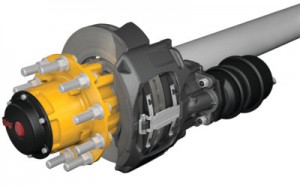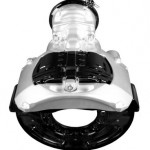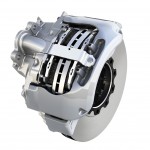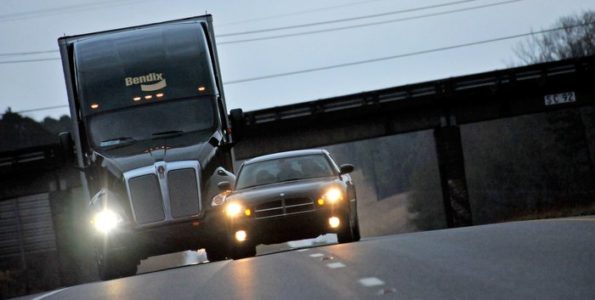
Advanced safety systems that employ radar- and camera-based technologies that enable adaptive cruise control and even autonomous truck operation rely heavily on one specific component—the brakes. The safety of these futuristic collision mitigation systems rests squarely on proper brake application, operation and maintenance.
“It’s important to keep in mind that advances in collision mitigation technology have moved forward with advances in brake system technologies. This includes stability systems and advanced wheel end systems including air disk brakes, and larger drum brakes designed to meet the reduced stopping distance regulations,” said Fred Andersky, director of customer solutions—controls and of government and industry affairs for Bendix Commercial Vehicle Systems. “Better braking systems help the performance and maintenance aspects of advanced driver assistance technologies.”
According to Hendrickson, the increased usage of radar- and camera-based systems could actually increase brake usage and frequency of maintenance intervals, at least during these initial years in the market.
“These types of systems take the human element out of the equation relying instead on computer programming to make assumptions about the conditions and frequency in which braking is necessary,” said Jeff Wittlinger, business unit director—wheel end and braking systems at Hendrickson. “Depending on how the system is programmed to react to certain situations [such as perceived road blocks or other hazardous conditions], the brakes may be activated more frequently than necessary resulting in increased usage and, over time, more frequent maintenance intervals. Even with increased adoption of these types of technologies, nothing can replace the value of an alert and conscientious driver.”
“Fewer emergency stops should result in less brake maintenance required,” according to Randy Petresh, vice president of technical services for Haldex. “The growing adoption of advanced radar- and camera-based safety systems have the potential to reduce brake intervals, since they are designed to minimize or significantly reduce aggressive braking. Projections or estimates will need to be qualified by actual fleet usage, duty-cycle and operational usage.”
While radar- and camera-based collision mitigation systems can be a great safety net for fleets, experienced and educated drivers remain one of the biggest factors for enhanced braking performance and extended maintenance intervals.

Before breaking down the nitty-gritty brake-spec’ing details, let’s check in on the growth of air disc brakes. Among the brake manufacturers that Fleet Equipment polled for this story, market penetration of air disc brakes (ADBs) ranged anywhere from 10% to 20% of truck orders, and around 5% to 10% of trailer orders. Overall, about 15% of the trucks ordered today are spec’d with ADBs.
According to the majority of brake manufacturers, cost is still the main hurdle in terms of ADB adoption. Fleet managers are looking at roughly $600 per axle premium when spec’ing ADBs compared to drum brakes.
Drum brakes continue to make up the majority of specs, driven by the implementation of reduced stopping distance (RSD) materials to help meet the requirements of NHTSA 49 CFR Part 571.
“With this material, truck manufacturers can achieve compliance without disc brakes,” said Jim Reis, Stemco’s vice president and general manager of brake products. “Most of our drum brake innovation has been focused on material formulation to improve stopping performance, extend replacement cycles and reduce noise and vibration.”
Additionally, some fleets have moved to a larger brake pad size in order to close the drum brake performance gap vs. ADBs, spec’ing to the 8 5/8-in. wide pad, which is 1 5/8-in. wider than the standard width of 7 in., according to Bill Hicks, director of product planning for the Americas at SAF-Holland, Inc.
“While some fleets have elected to go to wider drum brakes to meet the brake stopping distance requirements, the added weight and cost of the wider brakes negates some of the overall benefits of choosing this approach. In addition, the wider drums still suffer from drum brake fade,” Hicks explained. “This fundamental difference between disc and drum is why we see fleets moving to the overall performance improvement of an ADB system.”

Let’s not forget the cost factor. According to Keith McComsey, director of marketing and customer solutions for Bendix Spicer Foundation Brake, drum brake systems have continued to maintain their initial lower cost advantage (at the time of purchase) over ADB initial costs.
That said, air disc brakes can be more cost-effective over the life of the vehicle, according to Paul Chappell, director of product management, Foundation Brake, Haldex, because ADBs are not as complex, so they simplify maintenance, which reduces downtime.
Some fleets are spec’ing combinations to bridge cost with performance.
“We’re seeing varying trends for disc/drum combinations where customers are utilizing EX+ air disc brakes for steer axles to gain the performance benefits of an air disc brake while also specifying Q+ drum brakes on the rear axles to provide a high-performing and cost-effective solution for the entire braking system,” said T.J. Reed, Meritor’s general manager of brakes for North America.














